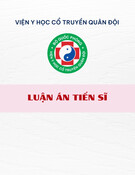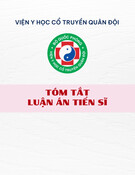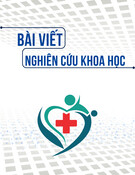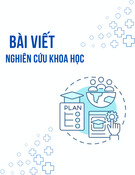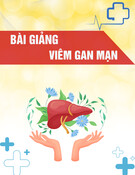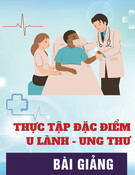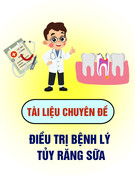Giải quyết các vấn đề lâm sàng: Cơ sở từ y học chứng cứ
GiẢNG VIÊN : GS TS BS LÊ HOÀNG NINH
Nội dung bài học
• Mục tiêu
• Các kỹ năng cần của y học chứng cứ
trong thực hành chăm sóc bệnh nhân:
– Kỹ năng đặt câu hỏi đúng về tình huống lâm sàng
của bệnh nhân
– Kỹ năng tìm kiếm các chứng cứ hiện có trên y văn
– Kỹ năng đánh giá các chứng cứ trên y văn
– Kỹ năng ứng dụng chứng cứ trên bệnh nhân của
thầy thuốc
Mục Tiêu
• Định nghĩa y học chứng cứ (EBM) • Tại sao thầy thuốc phải dùng y học chứng cứ – Compare with expert-based medicine – How are we misled by: • Surrogate outcomes • Personal observation • Pathophysiologic reasoning • Mô tả các công cụ y học chứng cứ • Xây dựng câu hỏi lâm sàng tốt
Y học chứng cứ là gì?
“ sử dụng chứng cứ tốt nhất hiện có vào thực hành chăm sóc bệnh nhân”
Cái gì là quan trọng khi đọc y văn
1. 2.
3.
4. 5. 6.
Các kết quả có liên quan tới bệnh nhân của bạn Trả lời được câu hỏi về chăm sóc bệnh nhân mà bạn đang gặp khó khăn Có thể làm bạn thay đổi thực hành chăm sóc bệnh nhân của bạn Là chủ đề mà bạn đang quan tâm theo dõi Là cái mà bạn cần biết rõ hơn, chi tiết hơn, cụ thể hơn Bạn cần về POEM or DOE •
Patient-oriented evidence ( POEM: bằng chứng hướng tới bệnh nhân) that matters vs disease-oriented evidence ( DOE : bằng chứng hướng tới bệnh )
Cái cần có ở y văn là
Y học chứng cứ
“Evidence-based medicine (EBM) requires the integration of the best research evidence with our clinical expertise and our patient’s unique values and circumstances”
EBM, 2006, Straus et al Y học chứng cứ đòi hỏi lồng ghép bằng chứng tốt nhất với kinh nghiệm lâm sàng và tình trạng , hoàn cảnh, điều kiện thực của bệnh nhân
Giá trị của việc học EBM: ( một thử nghiệm ngắn hạn)
• Một thử nghiệm có nhóm chứng về giảng dạy đánh giá y
văn được thực hiện trên sinh viên y khoa
• Nhóm thử nghiệm được học với thầy hướng dẫn đã qua
– Đánh giá các bài báo về test chẩn đoán và điều trị
khóa huấn luyện lâm sàng về: – Đánh giá các thử nghiệm lâm sàng
• Nhóm chứng được học với các thầy bình thường không
qua các khóa huấn luyện kể trên
Bennett et al. JAMA. 1987;257:2451-2454.
Giá trị việc học EBM: ( một thử nghiệm ngắn hạn tt) • Sinh viên nhóm thử nghiệm có quyết định chẩn đoán và điều trị đúng tốt hơn và họ có thể lập luận, bình luận trước khi ra các quyết định của họ
• Những sinh viên trong nhóm chứng thường ra các quyết định không đúng trong chẩn đoán và điều trị.
• Sinh viên trong nhóm chứng thường dễ chấp nhận những đề nghị từ những nhân vật có thẩm quyền.
Bennett et al. JAMA. 1987;257:2451-2454.
The Patient
• Patient is a 27-year-old woman with severe right lower
– initial peri-umbilical pain x 2 days migrating yesterday to
current site.
quadrant pain.
• Loss of appetite. No vomiting, diarrhea; no bowel
movement
• no known infectious exposure/
suspicious ingestions, or recent travel
• First, do no harm.
• How do we know
that we are not?
Hướng dẫn truyền thống trong thực hành y khoa
• Pathophysiology and pharmacology
– Foundation of medical practice
– Do what “makes sense”
• Expert opinion
– In training: learning at the bedside from the master clinician
– In practice: lectures and seminars with thought leaders
• Clinical experience
– Successes, outcomes, and adverse events
in our own practice
Lồng ghép chứng cứ
• Kinh nghiệm lâm sàng:
– Trải nghiệm – Cân nhắc, xem xét • Bối cảnh bệnh nhân
– Chất lượng cuộc sống – Chi phí – Những yếu tố khác…
Kinh nghiệm
Hiện trạng và Bối cảnh bệnh nhân
lâm sàng
Chứng cứ hiện có tốt nhất
Chi phí
Chất lượng cuộc sống
ĐiỀU TRỊ VÀ CHẨN ĐOÁN
Vấn đề của bệnh nhân
• Bệnh nhân nử 27 tuổi đau bụng dữ dội vùng bụng ¼
– initial peri-umbilical pain x 2 days migrating yesterday to
current site.
phải , dưới.
• Biếng ăn
• Không nôn mửa, tiêu chảy, không có nhu động ruột
• Không rõ tiếp xúc với nguồn nhiễm trùng, suspicious
ingestions, or recent travel
Xét Nghiệm
VS BP 120/78 P 16 T 39
Chest CTA. CV RRR s M/R/G
ABD: NML exam x decreased bowel tones and definite right lower quadrant pain, specifically at McBurney’s point.
no heptomegaly nor splenomegaly (enlarged liver or spleen). She has no rebound pain or involuntary
chuẩn 5 “A”
1. Ask the right question
2. Acquire the evidence
3. Appraise the evidence
4. Apply the evidence
5. Assess its impact
Concern:
• Case discussion: 27 year old woman with right lower
quadrant (RLQ) abdominal pain
– What typically presents as RLQ pain
– What is the clinical course of the different diagnoses
– Specifically, what is typical presentation of appendicitis
• Background information available from textbooks-
– How good is a CT scan for appendicitis?
• Foreground information
Đặt Câu Hỏi Lâm Sàng
Câu Hỏi Lâm Sàng
• Câu hỏi lý tưởng:
– Focused enough to be answerable
– Pertinent to clinical scenario
– Framed as
Population receiving an Intervention (test or treatment) [as Compared to other test/treatment or placebo] associated with Outcome (disease or improvement)
PICOS
P roblem/population
I ntervention
C omparison
O utcome
S tudy design
Examples of tough questions
• Should I screen men for prostate cancer?
• Who is a good candidate for hormone
replacement therapy?
• Are angiotensin receptor blockers now first-line
for hypertension?
Examples of better questions
• Would a PSA test reduce mortality in a 65 year-old
asymptomatic man?
• What is the reduction in fracture risk associated
with hormone replacement therapy?
• Is losartan more effective than atenolol at
preventing cardiovascular events in middle-aged hypertensive diabetic women?
PICOS
PICOS for confirmatory diagnosis of appendicitis
P:
27 year old woman with symptoms suggestive of appendicitis
I:
CT Scan
C:
Ultrasound
O:
Accurate diagnosis without undue delay
S:
??
Hệ quả quan trọng
• Hệ quả hướng tới bệnh nhân:
failure, etc.
– Ability to perform activities of daily living
outcomes patients actually care about – Death (overall or disease-specific) – Heart attacks, strokes, amputations, bed sores, broken hips, renal
Versus
– Biochemical, physiologic, pharmacologic, or laboratory measures
• Hệ quả hướng tới bệnh:
Comparing DOE and POE
Example
Antiarrhythmic Therapy Type 2 Diabetes
Comment POE contradicts DOE POE contradicts standard teaching
Disease-Oriented Evidence Drug X PVCs on ECG Aggressive Tx with insulin or oral agents can keep BS low
Prostate Screening
DOE exists, but POE is unknown
PSA screening detects prostate cancer early
Patient-Oriented Evidence that Matters Drug X increases mortality Aggressive Tx does not reduce mortality or prevent most complications Does PSA screening mortality?
Shaughnessy AF, Slawson DC. Getting the Most from Review Articles: A Guide for Readers and Writers. American Family Physician 1997 (May 1);55:2155-60.
Background versus foreground information
• Case discussion: 27 year old woman with right lower
quadrant (RLQ) abdominal pain
– What typically presents as RLQ pain
– What is the clinical course of the different diagnoses
– Specifically, what is typical presentation of appendicitis
• Background information available from textbooks-
– How good is a CT scan for appendicitis?
• Foreground information
Steps of EBM-5 A’s
• Ask • Acquire • Appraise • Apply • Assess
“Finding Evidence”: Sources (I)
• Primary research database (articles) – PubMed (aka MEDLINE), Pyschlit, CCTR
• Secondary research databases (synthesis)
– Cochrane Library, Clinical Evidence, InfoPOEMS,
• Tertiary resources (meta search engines,
databases of databases) – TRIP+ (Translating Research Into Practice),
UpToDate
PrimeEvidence
“Finding Evidence”: Sources
• PubMed
– 16 million peer reviewed biomedical articles indexed (note can use PubMed
limits to search on particular populations, study types, etc.)
• Cochrane Library
– ~3000 clinical systematic reviews (gold standard database)
• Clinical Evidence
– ~2500 tsystematic reviews of treatment classified by likelihood of benefit
• InfoPOEMS (www.infopoems.com)
– ~3000 regularly updated entries, Patient Oriented Evidence the Matters
(POEM), 100+ journals monitored
• UpToDate
– 70,000 pages, evidence based clinical information resource, ~3000 authors,
350+ journals monitored, peer reviewed
• TRIP+
– Meta-search of 55 sites of evidence based information
“Finding Evidence”: Searching
Chuyển câu hỏi lâm sàng thành câu hỏi đúng dễ tìm y văn (e.g. PICOS)
1.
Chọn nguồn dữ liệu mà bạn muốn tìm (e.g. PubMed)
2.
Áp dụng bộ lọc để khu trú y văn cần tìm (e.g. PubMed limits linked to PICOS
3.
such as gender, age, study type limits)
Đánh giá kết quả (e.g. using systematic review worksheet)
4.
Xem xét xem liệu bạn có đủ thông tin để ra quyết định không
5.
Nếu chưa đủ bạn phải đi lại các bước 1-3 cho đến khi bạn có được câu trả lời
6.
hoặc quyết địnhlà không đủ chứng cứ hoặc có đủ chứng cứ để ra quyết định
ĐÁNH GIÁ CHỨNG CỨ
Assess the Evidence
• Kết quả là có giá trị?
– Validity is defined as relative không có sai lệch hệ thống và yếu tố gây
nhiễu
• Kết quả gì?
– Hệ quả là gì và được đo lường bằng cách nào? – Độ lớn của hệ quả ? – Các Kết quả có ý nghĩa thống kê ?
• Kết quả áp dụng trên bệnh nhân được không? – Does my patient resemble those in the study? – Were all outcomes relevant to my patient evaluated? – Are there other factors (eg, cost, availability) that limit applicability to
my patient?
Guyatt et al. Users' Guides to the Medical Literature: A Manual for Evidence-Based Clinical Practice.
Chicago, IL: American Medical Association; 2001
Đánh giá chứng cứ (t.t)
• Phân biệt nghiên cứu quan sát và thực nghiệm
observational and experimental studies
• Phân biệt 2 major study designs (randomized controlled
trial and cohort study) : – How the study is designed – Advantages and disadvantages of design – How to assess validity – How to assess results – How to assess applicability
Nghiên cứu thực nghiệm và nghiên cứu quan sát
• In experimental studies, the investigator controls subjects’
exposure to intervention
– Example: randomized controlled trial (RCT)
• In observational studies, investigator does not control the
exposure; it occurs naturally or is initiated by patients or their physicians
– Examples: cohort study, case-control study
Guyatt et al. Users' Guides to the Medical Literature: A Manual for Evidence-Based Clinical
Practice. Chicago, IL: American Medical Association; 2001.
RCTs
Treatment
Generally held to be the optimal methodology for determining benefit or harm
Outcome
Randomization
Eligible Patients
Outcome
Control
Guyatt et al. Users' Guides to the Medical Literature: A Manual for Evidence-Based Clinical Practice. Chicago, IL: American Medical Association; 2001.
RCTs: ích lợi
• Treatment and control groups are likely to have similar distribution of known and unknown prognostic factors (potential confounders)
• Outcomes are determined prospectively in a
standardized, systematic fashion
Guyatt et al. Users' Guides to the Medical Literature: A Manual for Evidence-Based
Clinical Practice. Chicago, IL: American Medical Association; 2001.
RCTs: Disadvantages
• Costly to perform
• Size limitations make detection of rare events
difficult (eg, adverse medication effects)
• Eligibility restrictions may reduce applicability to
real patients
• Cannot be ethically performed if exposure is
expected to cause harm (eg, smoking)
Guyatt et al. Users' Guides to the Medical Literature: A Manual for Evidence-Based Clinical Practice.
Chicago, IL: American Medical Association; 2001.
RCTs: Disadvantages
• Costly to perform
• Size limitations make detection of rare events
difficult (eg, adverse medication effects)
• Eligibility restrictions may reduce applicability
to real patients
• Cannot be ethically performed if exposure is
expected to cause harm (eg, smoking)
Guyatt et al. Users' Guides to the Medical Literature: A Manual for Evidence-Based Clinical Practice. Chicago, IL:
American Medical Association; 2001.
Đánh giá giá trị các RCTs
• Was randomization concealed?
• Were patients analyzed in groups to which they were
randomized?
• Were patients in treatment & control groups similar
with respect to prognostic factors?
• Were patients, clinicians, outcome assessors, and
data analysts aware of allocation?
• Were groups treated equally?
• Was follow-up complete?
Guyatt et al. Users' Guides to the Medical Literature: A Manual for Evidence-Based Clinical Practice. Chicago,
IL: American Medical Association; 2001.
Đánh giá kết quả RCT
• Magnitude of result: How large was the treatment
effect? – Relative risk and odds ratio – Absolute risk reduction and number needed to treat (NNT)
– P value – Confidence interval: How precise was estimate of treatment
effect?
• Statistical significance
• Clinical significance
Guyatt et al. Users' Guides to the Medical Literature: A Manual for Evidence-Based Clinical
Practice. Chicago, IL: American Medical Association; 2001.
Calculating the Risk Ratio and Number Needed to Treat (NNT)
Treatment (n = 1000)
100 have the outcome
Risk = 0.1, or 10% (100/1000)
Control (n = 1000)
120 have the outcome
Risk = 0.12, or 12% (120/1000)
Risk ratio = 0.1/0.12 = 0.83, or 83%
Absolute risk reduction = 0.12 - 0.1 = 0.02, or 2%
NNT = 1/0.02 = 50
Guyatt et al. Users' Guides to the Medical Literature: A Manual for Evidence-Based Clinical Practice. Chicago, IL: American Medical Association; 2001.
Đánh giá tính ứng dụng RCT
• Were the study patients similar to
my patient? – Eligibility criteria – “Table 1” data (baseline characteristics) • Were all clinically important outcomes
considered?
• Are the likely treatment benefits worth the
potential harm and costs?
Guyatt et al. Users' Guides to the Medical Literature: A Manual for Evidence-Based Clinical Practice.
Chicago, IL: American Medical Association; 2001.
Cohort Studies
• Similar to RCTs, except that assignment
to intervention is not random
Outcome
Exposed
Eligible Patients
Choice or Happenstance
Outcome
Not Exposed
Guyatt et al. Users' Guides to the Medical Literature: A Manual for Evidence-Based Clinical Practice. Chicago, IL: American Medical Association; 2001.
Lợi ích nghiên cứu đoàn hệ
• Outcomes are determined prospectively in a
standardized, systematic fashion
• Often includes a larger, more diverse
population than those eligible for or included in RCTs
• Can be used to assess effects of harmful
exposures (eg, smoking)
Guyatt et al. Users' Guides to the Medical Literature: A Manual for Evidence-Based Clinical
Practice. Chicago, IL: American Medical Association; 2001
Hạn chế nghiên cứu đoàn hệ
• Costly to perform • Size limitations make detecting rare events
difficult
• Exposure and control groups are likely to differ in factors that may affect outcomes • Control of confounding through statistical
analysis may be inadequate
Guyatt et al. Users' Guides to the Medical Literature: A Manual for Evidence-Based Clinical Practice. Chicago, IL: American Medical Association; 2001.
Đánh giá giá trị nghiên cứu đoàn hệ
• Were the exposed and control groups similar in
all known determinants of outcome? – Did the analysis adjust for potential differences?
• Were the outcomes measured in the same way
in the groups being compared?
• Was follow-up sufficiently complete?
Guyatt et al. Users' Guides to the Medical Literature: A Manual for Evidence-Based Clinical Practice.
Chicago, IL: American Medical Association; 2001.
Đánh giá kết quả NC Đoàn Hệ
• How strong is the association between exposure and
outcome? – Risk ratio or odds ratio – Absolute risk increase or number needed to harm (NNH)
– P value – Confidence interval: How precise was estimate of risk?
• Statistical significance
• Clinical significance
Guyatt et al. Users' Guides to the Medical Literature: A Manual for Evidence-Based Clinical
Practice. Chicago, IL: American Medical Association; 2001.
Đánh giá tính ứng dụng Cohort Study
• Were the study patients similar to the patient under consideration in my practice?
• Should I attempt to stop the exposure?
Guyatt et al. Users' Guides A Manual for Evidence-Based Clinical Practice. Chicago, IL:
American Medical Association; 2001 to the Medical Literature:.
Nghiên cứu bệnh-chứng
• In contrast to RCTs and cohort studies,
participants are selected based on the presence of the outcome rather than the exposure
• Exposure status is determined retrospectively
Guyatt et al. Users' Guides to the Medical Literature: A Manual for Evidence-Based Clinical
Practice. Chicago, IL: American Medical Association; 2001.
Case-Control Studies: Design
Select Subjects:
Cases (diseased)
Controls (nondiseased)
Observe:
Exposed
Not Exposed
Exposed
Not Exposed
Guyatt et al. Users' Guides to the Medical Literature: A Manual for Evidence-Based Clinical Practice. Chicago, IL: American Medical Association; 2001.
Lợi ích Case-Control Studies
• Much more efficient for investigation
of rare outcomes
• Take less time to perform than RCTs
or cohort studies
Guyatt et al. Users' Guides to the Medical Literature: A Manual for Evidence-Based
Clinical Practice. Chicago, IL: American Medical Association; 2001.
Hạn chế Case-Control Studies
• Retrospective assessment of exposure may be
inadequate (recall bias)
• Can be performed only after outcomes have occurred
(ie, after damage has already occurred)
• Selection of appropriate controls may be difficult • Control of confounding through statistical analysis may
be inadequate
Guyatt et al. Users' Guides to the Medical Literature: A Manual for Evidence-Based Clinical
Practice. Chicago, IL: American Medical Association; 2001.
Các bước EBM-5 A’s
• Ask • Acquire • Appraise • Apply • Assess
Applying EBM
Clinical Expertise
Patient Values and Preferences
Best Available Evidence
Costs
Quality of Life
Xem xét kết quả nghiên cứu điều trị
VALIDITY • • • • •
•
Clearly focused question? Randomization Blinding- subjects, providers, investigators Groups similar at start and treated the same throughout? Followed in randomized groups and accounted for at end? (intention to treat) Enough subjects to minimize chance differences?
REUSLTS AND PRECISION 1. What are results? How presented? 2.
Certainty & precision? (95% CI’s)
APPLICABILITY 1. 2. 3.
Can the results be applied to my patient? All important outcomes addressed? Should there by change in policy?
“Therapy”: Intention to treat
• Subjects are analyzed in the groups they
were randomized to. – Maintains randomization – Better reflects real world outcomes – Measures efficacy (“Will this work?”) – Detects issues about intervention other than
effectiveness “In the best possible circumstances, do they work?”
“Therapy”: Bias
• Randomization helps lessen patient bias
• Blinding helps lessen patient and
investigator bias
– Self-selection
“Điều trị ”: kết quả thế nào ?
• RR OR RRR
• ARR
• NNT / NNH
• P value/ CI
• Clinically significant?
“Điều trị”: Diễn đạt các kết quả
Risk = outcome event rate
= number having event
number receiving the intervention
Relative risk = risk in intervention group
(RR) risk in control group
Relative risk reduction (RRR) = 1 - RR
“Điều trị ”: Diễn đạt các kết quả
Absolute risk reduction (ARR) = difference in risk
(control – intervention)
“Diễn đạt các Kết quả
Number-needed-to-treat (NNT) = 1/ARR
NNT: là số bệnh nhân cần được điều trị nhằm ngăn ngừa một biến cố, một hệ quả có thể xảy ra trong một thời khoảng nhất định nào đó
“Thí Dụ về N. C Điều Trị
• Một thử nghiệm điều trị bệnh ung thư bằng một loại thuốc mới , sau 4 năm theo dõi cho thấy tử vong như sau:
• Nhóm thử nghiệm: 30% 50% • Nhóm chứng : • Tính RR, RRR, ARR, NNT?
“ Thí dụ .NC Điều Trị”
RR = risk of death in experiment/control groups
= 30%/50% = 0.6 or 60%
RRR = 1 - RR = 1-0.6 = 0.4 or 40%
ARR = risk of death in control – experimental groups
= .50 -.30 = 0.2 or 20%
NNT =1/ARR = 1 ÷ 0.2
vong trong 4 năm
= 5 bệnh nhân cần điều trị bằng thuốc mới để ngừa tử
“Therapy”: Relative Versus Absolute Benefits
• Consider
– July 3, 2002: Worldcom stock rose 120%
(relative increase)
– The stock rose from: $0.10 $0.22 (absolute
increase)
“NC Điều Trị”: Giảm Nguy Cơ tương đối – Giảm nguy cơ tuyệt đối
• Baseline risk 10/100
5/100 ARR = 5% NNT = 20
• Baseline risk RRR = 50%
0.5/100 1/100 ARR = 0.5% NNT = 200
• Baseline risk RRR = 50%
0.05/100 0.1/100 ARR = 0.05% NNT = 2000
RRR = 50%
“Therapy”: RRR Lipid Trials
4S WOSCOPS CARE AFCAPS
31
25
40
42
40
435
RRR 27 (%) NNT 19 (5 year)
for acute myocardial infarction
“NC Điều Trị”: Khoảng Tin Cậy 95%
• Any statistic only an estimate of the “true value” of that
statistic.
• Confidence Interval (CI) gives range within which that “true
value” probably lies.
• 95% CI - if we repeated the experiment with similar
populations an infinite number of times, the results would fall within the CI 95% of the time. 95% certain that the “true value” will fall within the 95% CI range.
• CI gives us an idea of the precision of the result, since the narrower the CI is, the more certain we can be that the experimental value is close to the “true value”.
• And, generally, the larger the sample size, the narrower the CI
• CI =idea of significance, e.g.
– If the 95% CI for the ARR includes 0, no difference between the
experimental and control groups.
– If the 95% CI for the RRR or Odds Ratio includes 1, no difference
between the experimental and control groups.
• Similar to P values (e.g., P<0.05) =statistically significant
• CI gives a sense of the size of the differences found in the study.
• e.g., research study - 50% of patients treated with Drug A are cured,
compared with 45% of patients treated with Drug B.
• ARR I s thus 5%. • Statistical analysis P<0.001, statistically significant. • But if 95% CI of ARR is 0% to 10%, indicates result is not clinically
significant (includes “0%” - “no difference”).
“NC Điều Trị”: ý nghĩa thống kê ý nghĩa lâm sàng
• Are the results clinically important?
– Duration of pharyngitis: 8.1 days to 7.4 days
– Weight: 279 lbs to 266 lbs after 3 months
– Survival increased from 4.5 mos to 5.2 mos with 100% mortality at
12 months
– Claudication: Increase in walking distance by 34 ft.
“Bình Luận về Chẩn Đoán”: Bộ Công cụ
TÍNH GIÁ TRỊ : • • •
Câu hỏi có tập trung, rõ ràng không? Chuẩn có phù hợp không? Chuẩn tham khảo & test áp dụng cho mọi đối tượng không? (verification bias) Kết quả có bị ảnh hưởng bởi sự giải thích kết quả không? (review bias) Tình trạng bệnh được váo cáo và các thay đổi có không? (spectrum bias) Phương pháp kiểm có đủ chi tiết để làm lại được không?
• • •
KẾT QUẢ VÀ TÍNH CHÍNH XÁC 1. 2.
Kết quả gì? Có chắc và chính xác không ? Certainty & precision? (95% CI’s)
TÍNH ƯNG DỤNG 1. 2.
Kết quả có áp dụng cho bệnh nhân khác không? Nguồn lực địa phương có đủ để triển khai những kết quả nầy không?
“Chẩn đoán ”: Bảng 2X2 Các đặc trưng của test chẩn đoán
• Sensitivity
• Specificity
• Predictive Value
• Likelihood Ratios
DIAGNOSTIC TEST
TOTALS
D I S E A S E Absent Present
T
All positive
Test positive
E
Test negative All negative
S
TOTALS
Entire population
T
True Positive False Negative All with disease
False Positive True Negative All without disease
“Diagnosis”: What are the Results?
D I S E A S E
(+)
(-)
(+)
a
b
T
E
(-)
c
d
S
T
“Diagnosis”: What are the Results?
Dz (-)
Pt has disease Dz (+)
Test(+)
a
b
Test(-)
c
d
“Diagnosis”: What are the Results?
Dz (+)
Pt does not have disease Dz (-)
Test(+)
a
b
Test(-)
c
d
“Diagnosis”: Sensitivity
Sensitivity is proportion of people with disease who have a positive test
Dz (+)
Dz (-)
Test(+)
a
b
TP
Test(-)
c
d
FN
Sensitivity = (a/a+c) =(TP/TP+FN)
“Diagnosis”: What are the Results?
Dz (+)
Pt does not have disease Dz (-)
Test(+)
a
b
Test(-)
c
d
“Diagnosis”: Specificity
Specificity is proportion of people without disease who have negative test
Dz (+)
Dz (-)
Test(+)
a
b
FP
Test(-)
c
d
TN
Specificity = (d/b+d) =(TN/FP+TN)
“Diagnosis”: Tradeoffs of sensitivity & specificity labeling diabetes
Blood sugar Sensitivity Specificity
• 70 • 100 • 130 • 160 • 200 98.6% 88.6% 64.3% 47.1% 27.1% 8.8% 69.8% 96.9% 99.8% 100%
“Diagnosis”: Choosing a test
• SnNout-
A sensitive test, if negative, rules out a disease
• SpPin-
A specific test, if positive, rules in a disease
“Diagnosis”: Sensitivity & Specificity
• Useful for picking a test (test properties)
– Screening- prefer sensitive test
• Less help in making diagnosis
– Diagnosis – prefer specific test
“Diagnosis”: What are the Results?
• In patients, what you know are their test results- you are trying to
determine whether they actually have the disease.
• Positive Predictive Value :
– Of all who tested positive for a disease, the proportion that actually has it
• Negative Predictive Value :
– Of all who tested negative for a disease, the proportion that actually does
not have it
“Diagnosis”: What are the Results?
D I S E A S E
(+)
(-)
(+)
a
b
T
E
(-)
c
d
S
T
“Diagnosis”: Positive Predictive Value
Proportion of people with a positive test
Dz (+) Dz (-)
Test(+)
who have a disease
PPV =
TP a
FP b
a/a+b=
TP/TP+FP
Test(-)
= true positives
c
d
over all positives
“Diagnosis”: Negative Predictive Value
Proportion of people with a negative test
Dz (+) Dz (-)
Test(+)
who don’t have a disease
NPV=
d/d+c=
Test(-)
TN/TN+FN
FP b TN d
a FN c
= true negatives
over all positives
“Diagnosis”: What are the Results?
• Example: Prevalence of a particular disease in a population
is 50%. Sensitivity= 90% Specificity= 95%
Dz (+) Dz (-)
Test(+)
PPV: = a/a+b
90
5
a
b
Test(-)
= 95%
10
95
d
PPV dependent on prevalence, even when using the same test
200
c 100
100
“Diagnosis”: PPV & prevalence
• Example: Prevalence of a particular disease in a population
is 5%. Same test, same sensitivity & specificity – Sensitivity= 90% Specificity= 95%
Dz (+) Dz (-)
PPV: = a/a+b
Test(+)
9
10
a
b
Test(-)
= 47%
1
180
c
d
PPV dependent on prevalence using same test
200
10 190
“Diagnosis”: PPV & NPV
–
Probability of disease after (+ ) or (–) test
• Useful for diagnosis
– –
Sensitive to prevalence of disease Prevalence of disease in general population may not be the same as that of patients you see in clinic/ER. – Not all test results can be categorized as “+” or “-”.
• Drawbacks:
For these reasons, some consider PPV & NPV “Old
School”.
“Diagnosis”: What are the Results?
Likelihood Ratios
• Likelihood Ratio is how much more likely is it
that someone with this finding has the disease, compared to someone who doesn’t. It does NOT vary with prevalence.
Technically, the + LR is how much more likely
someone is to get any positive test result if they have disease, compared to someone who doesn’t.
“Diagnosis”: Likelihood ratio
LR = SENSITIVITY
1 - SPECIFICITY
“Diagnosis”: What do all the numbers mean?
The Likelihood Ratio is a diagnostic weight;
It tells you by how much a given diagnostic test result will raise or lower the probability of having the disorder.
Pretest Probability: the chance that the pt has disease, prior to ordering any tests. This is often an estimation based on clinical experience
Post-test Probability: the chance that the pt has disease,
given the results of the test
“Diagnosis”: What are the Results?
A LR of 1.0 means the post-test probability is exactly the
same as the pretest probability.
A LR >1.0 increases the probability of having the disorder.
A LR<1.0 decreases the probability of having the disorder.
What do all the numbers mean?
“Diagnosis”: What are the Results?
Likelihood ratios >10 or <0.1 generate large changes from pre- to post-test probability and are generally considered significant.
Strong evidence to rule in/rule out a diagnosis.
Likelihood ratios of 5-10 and 0.1-0.2 generate moderate changes
in probability.
Moderate evidence to rule in/rule out a diagnosis.
Likelihood ratios of 2-5 and 0.2-0.5 generate small changes.
Minimal evidence to rule in/rule out a diagnosis
Likelihood ratios 0.5-2 usually have little effect
Figure 1a: Likelihood Ratio Nomogram
LRs = Diagnostic Weights
Likelihood Ratio
Change in probability
Values greater than 1 INCREASE probability of disease
From Steve McGee, Evidence Based Physical Diagnosis
Values between 0 and 1 DECREASE probability of disease 10 5 2 1.0 0.5 0.2 0.1 +45% +30% +15% 0 -15% -30% -45%
Table 2a: Likelihood Ratios of Tests for the Diagnosis of Appendicitis
Likelihood ratio
• DVT
+LR 1.5
• ANEMIA
– Homan’s sign – Doppler + LR 39
– Conjunctival rim pallor +LR 16.7
Summary Diagnostic Test
D I S E A S E
TOTALS
Present Absent
T
Positive
ALL Positives
P P V
E
Negative
S
ALL Negatives
N P V
T
TOTALS
Entire population True Positive False Negative All with disease
False Positive True Negative All without disease
Sensitivity
Specificity
Explanation
This is a relative decrease & they used rates per 1000
33% sounds great, but…
Common pitfalls
– (ex. Migraines, CVA & OC)
• Results reported as relative risk
• Results that came from recalculating the data after
trial was done – (Post-hoc analysis) (ex. Hot study)
• Over-interpreting results • Relying on just one study (ex. Mg for heart dz), a poor study, or wrong type of study (ex. HRT)
• Confusing statistical significance with clinical
significance (ex. Drugs for BPH)
• Not looking at CI’s • Not considering who funded study
Steps of EBM-5 A’s
• Ask • Acquire • Appraise • Apply • Assess
Core of EBP
“Supposing is good but finding out is better.”
Mark Twain




